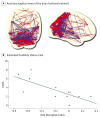Use of Advanced Magnetic Resonance Imaging Techniques in Neuromyelitis Optica Spectrum Disorder
- PMID: 26010909
- PMCID: PMC4828237
- DOI: 10.1001/jamaneurol.2015.0248
Use of Advanced Magnetic Resonance Imaging Techniques in Neuromyelitis Optica Spectrum Disorder
Abstract
Brain parenchymal lesions are frequently observed on conventional magnetic resonance imaging (MRI) scans of patients with neuromyelitis optica (NMO) spectrum disorder, but the specific morphological and temporal patterns distinguishing them unequivocally from lesions caused by other disorders have not been identified. This literature review summarizes the literature on advanced quantitative imaging measures reported for patients with NMO spectrum disorder, including proton MR spectroscopy, diffusion tensor imaging, magnetization transfer imaging, quantitative MR volumetry, and ultrahigh-field strength MRI. It was undertaken to consider the advanced MRI techniques used for patients with NMO by different specialists in the field. Although quantitative measures such as proton MR spectroscopy or magnetization transfer imaging have not reproducibly revealed diffuse brain injury, preliminary data from diffusion-weighted imaging and brain tissue volumetry indicate greater white matter than gray matter degradation. These findings could be confirmed by ultrahigh-field MRI. The use of nonconventional MRI techniques may further our understanding of the pathogenic processes in NMO spectrum disorders and may help us identify the distinct radiographic features corresponding to specific phenotypic manifestations of this disease.
Figures




Similar articles
-
Advanced magnetic resonance imaging of neuromyelitis optica: a multiparametric approach.Mult Scler. 2012 Jun;18(6):817-24. doi: 10.1177/1352458511431072. Epub 2011 Dec 19. Mult Scler. 2012. PMID: 22183930
-
Diffusion tensor imaging characterization of occult brain damage in relapsing neuromyelitis optica using 3.0T magnetic resonance imaging techniques.Neuroimage. 2012 Feb 15;59(4):3173-7. doi: 10.1016/j.neuroimage.2011.11.022. Epub 2011 Nov 13. Neuroimage. 2012. PMID: 22108642
-
Quantitative MRI analysis of the brain after twenty-two years of neuromyelitis optica indicates focal tissue damage.Eur Neurol. 2013;69(4):221-5. doi: 10.1159/000345799. Epub 2013 Jan 10. Eur Neurol. 2013. PMID: 23344153
-
Conventional brain MRI in neuromyelitis optica.Eur J Neurol. 2012 Jun;19(6):812-9. doi: 10.1111/j.1468-1331.2011.03565.x. Epub 2011 Oct 31. Eur J Neurol. 2012. PMID: 22040258 Review.
-
[Neuromyelitis optica is a frequently seen inflammatory demyelinating disease].Ugeskr Laeger. 2013 May 6;175(19):1331-5. Ugeskr Laeger. 2013. PMID: 23663369 Review. Danish.
Cited by
-
Update on the diagnosis and treatment of neuromyelitis optica spectrum disorders (NMOSD) - revised recommendations of the Neuromyelitis Optica Study Group (NEMOS). Part II: Attack therapy and long-term management.J Neurol. 2024 Jan;271(1):141-176. doi: 10.1007/s00415-023-11910-z. Epub 2023 Sep 7. J Neurol. 2024. PMID: 37676297 Free PMC article. Review.
-
A window into the future? MRI for evaluation of neuromyelitis optica spectrum disorder throughout the disease course.Ther Adv Neurol Disord. 2021 May 9;14:17562864211014389. doi: 10.1177/17562864211014389. eCollection 2021. Ther Adv Neurol Disord. 2021. PMID: 34035837 Free PMC article. Review.
-
The use of targeted genomic capture and massively parallel sequencing in diagnosis of Chinese Leukoencephalopathies.Sci Rep. 2016 Oct 25;6:35936. doi: 10.1038/srep35936. Sci Rep. 2016. PMID: 27779215 Free PMC article.
-
Cognitive Impairment in Neuromyelitis Optica Spectrum Disorders: A Review of Clinical and Neuroradiological Features.Front Neurol. 2019 Jun 12;10:608. doi: 10.3389/fneur.2019.00608. eCollection 2019. Front Neurol. 2019. PMID: 31258505 Free PMC article. Review.
-
Neuroinfection & neuroimmunology: New opportunities, new challenges.Radiol Infect Dis. 2016 Jun;3(2):51-53. doi: 10.1016/j.jrid.2016.03.008. Epub 2016 Apr 4. Radiol Infect Dis. 2016. PMID: 32289069 Free PMC article. No abstract available.
References
-
- Ito S, Mori M, Makino T, Hayakawa S, Kuwabara S. “Cloud-like enhancement” is a magnetic resonance imaging abnormality specific to neuromyelitis optica. Ann Neurol. 2009;66(3):425–428. - PubMed
-
- Makino T, Ito S, Mori M, Yonezu T, Ogawa Y, Kuwabara S. Diffuse and heterogeneous T2-hyperintense lesions in the splenium are characteristic of neuromyelitis optica. Mult Scler. 2013;19(3):308–315. - PubMed
-
- Pittock SJ, Weinshenker BG, Lucchinetti CF, Wingerchuk DM, Corboy JR, Lennon VA. Neuromyelitis optica brain lesions localized at sites of high aquaporin 4 expression. Arch Neurol. 2006;63(7):964–968. - PubMed
-
- Yonezu T, Ito S, Mori M, et al. “Bright spotty lesions” on spinal magnetic resonance imaging differentiate neuromyelitis optica from multiple sclerosis. Mult Scler. 2014;20(3):331–337. - PubMed
Publication types
MeSH terms
Grants and funding
LinkOut - more resources
Full Text Sources
Other Literature Sources
Medical

